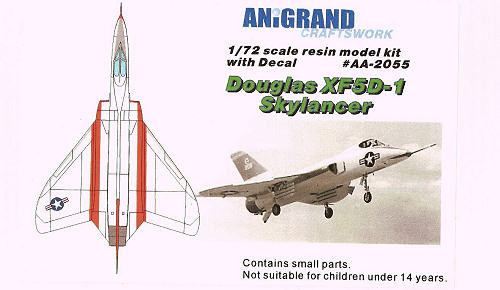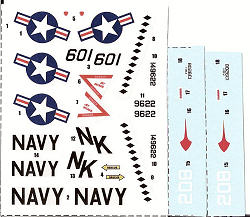
| KIT: | Anigrand 1/72 XF5D-1 Skylancer |
| KIT #: | AA-2055 |
| PRICE: | $49.00 MSRP |
| DECALS: | Two options |
| REVIEWER: | Mark Soppet |
| NOTES: | Resin with vacuformed canopy |

| HISTORY |
While the Douglas Skyray was the US Navyís first supersonic fighter, it could also be said that the plane was doomed from the start. Like the Demon and Skywarrior, the Skyray was designed around the Westinghouse J40 turbojet. When the Westinghouse engine became available, it was clear that the engine was underpowered and unreliable. The Skyray and Skywarrior were redesigned to accept the J57 from Pratt & Whitney, which also powered the B-52, KC-135A, the Super Sabre, Delta Dagger, and Voodoo.
The J57-powered Skyray was an improvised solution. Ed Heinemann and the rest of the Douglas engineering team knew they could refine the Skyray to take full advantage for the mighty J57. In 1953 (before the Skyray entered operational use,) Douglas pitched the F4D-2N, an all-weather variant of the Skyray.
By the time this new airplane was built, it had evolved into the F5D-1 Skylancer. The plane was longer than the Skyray with a new canopy, taller vertical tail, and thinner fillets between the wing and fuselage. The wings were thinner in cross-section but had thicker skins, to avoid the skin buckling that occurred on the Skyray.
The Skylancer was a success, by all accounts. Unlike the Skyray, it exceeded the speed of sound on April 21, 1956, during its first flight. The Skylancerís biggest flaw is that it arrived on the scene too late. Its performance was similar to the Crusader (which had flown nearly a year before the Skylancer) and the F11F Tiger (which had flown in July 1954.) The Skylancer didnít receive funding for further production, and a proposed Skylancer with a J79 engine (which would have surpassed the Crusader in most areas) didnít proceed.
Of the four Skylancer prototypes, two were transferred to NASA after the programís cancellation. They served as chase planes during the HL-10 lifting body program. One was famously flown by Neil Armstrong to simulate the pad abort profile of the X-20 DynaSoar. The other flew with an extended leading edge, testing the ďOgee WingĒ concept. The only surviving Skylancer on public display can be found at the Neil Armstrong museum in Wapakoneta, Ohio.
| THE KIT |
 Anigrandís
Skylancer consists of 23 resin parts, cast in a creamy tan color. A single
vacuformed canopy is also provided. They come in a sturdy box, and the parts
bag is sealed into three compartments which prevent the larger parts, smaller
parts, and canopy from scratching each other.
Anigrandís
Skylancer consists of 23 resin parts, cast in a creamy tan color. A single
vacuformed canopy is also provided. They come in a sturdy box, and the parts
bag is sealed into three compartments which prevent the larger parts, smaller
parts, and canopy from scratching each other.
The casting of the resin is good, but doesnít measure up to the high benchmarks set by companies like Cutting Edge and Fisher models. The scribing of the panel lines is heavy, reminiscent of some Italeri kits. Detail is provided in the main gear wells, but not in the nose gear well. There arenít too many blemishes in the resin parts, but there are very noticeable holes and flash around the wingtips. Molding on the vac-form canopy looks crisp, and it shouldnít be too hard to separate from the sheet.
I havenít been able to compare this kit to the plans in Steve Ginterís Skylancer book, but I can say that it truly looks like a Skylancer. The wing planforms match up well with the similar wings from the Tamiya Skyray. Test fitting the wings to the fuselage reveals that the alignment pegs will need to be sanded down to achieve a good fit.
Noticeably, the instrument consoles in the kitís cockpit are too narrow. Due to the thickness of the resin fuselage, Anigrand had to skimp on the consoles in order to fit the ejection seat. One plan of attack is to obliterate the kitís cockpit from the inner fuselage using a Dremel tool, and to cannibalize the cockpit and nose gear wheel from the Airfix or Tamiya Skyray.
For that matter, the kit seat doesnít
look very convincing. I donít have good info on the Skylancerís ejection seat,
but the available photos and drawings depict a seat that resemble s
an ESCAPAC with a modified headrest. I plan on substituting a Skyhawk ejection
seat and modifying it to resemble the Skylancer seat.
s
an ESCAPAC with a modified headrest. I plan on substituting a Skyhawk ejection
seat and modifying it to resemble the Skylancer seat.
Comparing the landing gear of this kit to the gear on the Tamiya Skyray reveals that Anigrand made some simplifications to the main gear assemblies. I also have concerns that the gear wonít be strong enough to support the weight of the completed model. My current plan is to add the missing gear pieces from thin metal rod, which will hopefully give the gear some extra strength and stiffness.
Decal options are for one of the four prototype planes (number 208) and a hypothetical plane (actually the large sheet is from their XFV-12 kit and is only included for the common markings. Ed). Disappointingly, there are no markings for the planes while in NACA or NASA service. The NACA tail bands might be scavenged from the Trumpeter F-107, and the NASA meatballs have been on numerous decal sheets for kits like the Space Shuttle, T-38, F-104, and U-2.
| CONCLUSIONS |
The Anigrand Skylancer is a pricey kit that will be a more challenging build than most. But itís the only game in town for a model of the Skylancer, unless you happen to have snatched the Maintrack vacuform kit from several years ago. At least the Skylancer is close enough to the Skyray that some parts can be cannibalized, with modifications, from the Airfix or Tamiya kits. Recommended to fans of 50ís naval aircraft or to any builder looking for a challenge.
July 2006
If you would like your product reviewed fairly and quickly by a site that has over 300,000 visitors a month, please contact me or see other details in the Note to Contributors.